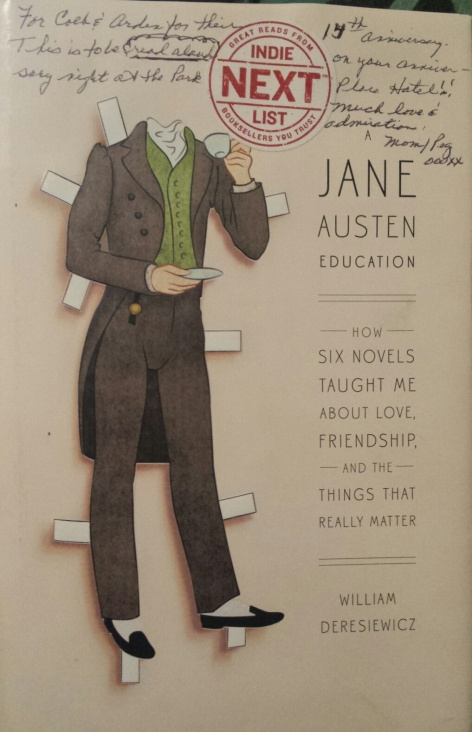“I have seen a great deal of him, have studied his sentiments, and heard his opinion on subjects of literature and taste; and, upon the whole, I venture to pronounce that his mind is well-informed, his enjoyment of books exceedingly great, his imagination lively, his observation just and correct, and his taste delicate and pure… I do not attempt to deny that I think very highly of him– that I greatly esteem, that I like him. ”
-Elinor, Sense and Sensibility
A Jane Austen Education: How Six Novels Taught Me About Love, Friendship and the Things That Really Matter by William Deresiewicz
On the cover of my book, there was a note. Never really paying the cover my full respects, I assumed it was supposed to be there. However, in the gap between completing the first chapter and moving on to the second, I studied the outside sheet of the book. Finally, I had read the note, and from that point, the rest of the novel started to make sense. It said:
“For Colb and Arden for their 14th anniversary. This is to be read aloud (emphasis in original) on your anniversary night at the Park Place Hotel!! Much love and admiration, Mom/Peg OOOXX”
Suddenly, not only did I have the story my author had so delicately put together, but I also had this mystery to solve. Why would anyone ever read this on their anniversary? Who were these “Colb and Arden” people? What did this book mean to them or their mother that she would give this as a gift? Chapter by chapter, I began to solve my mystery case.
In A Jane Austen Education, Deresiewicz interweaves his own story with Jane Austen’s and the characters’ lives of her novels. Seemingly a daunting task, Deresiewicz completes it flawlessly. Surprisingly, there was much more to be connected than what I could have ever imagined, even with my own life. In his book, there were six chapters, each one corresponding to one of the six books Austen published in her life (Emma, Pride and Prejudice, Northanger Abbey, Mansfield Park, Persuasion, and Sense and Sensibility).
As a professor, Deresiewicz encourages his students to be the developers of their own thought processes. Only supplying learners with the information they need, A Jane Austen Education is written the same way. With wit and a splash of comedy, Deresiewicz encourages his readers to tie their own lives with his, Austen’s, and her characters. Never forcing a certain direction, he creates a comfortable environment for self-connection.
The further I got into the book, the more I grew to like it and appreciate its worth. As the quote at the top of this post notes (taken from Deresiewicz’s connection to Sense and Sensibility, showing that true love is based on time and growing together), it took careful thought and consideration to fall in love with what Deresiewicz’s was sharing with his reader.
However, this wasn’t the only chapter that led me to rethink my own perceptions of key components in my life. Each chapter offered me something new to reconsider:
Emma: Pay attention to everyday things
Pride and Prejudice: You aren’t born perfect
Northanger Abbey: Stay awake; don’t take things for granted
Mansfield Park: Being entertained is not the same as being happy
Persuasion: Be honest with your friends
Sense and Sensibility: Love is about growing up, not staying young.
These were not the only things I learned from his sections. Though it is shameful for me to admit as an English major, I have never read Jane Austen, but Deresiewicz’s novel makes me want to stop everything I should be doing to prepare for finals and read every single one of her books.
I definitely recommend this novel! It’s worth checking out and you won’t regret it.
Other Key Quotes:
“Austen, I realized, had not been writing about everyday things because she couldn’t think of anything else to talk about. She had been writing about them because she wanted to show how important they really are.”
“Jane Austen’s life may have seemed uneventful compared to her aunt’s or cousin’s or brothers’, or indeed, compared to just about anyone’s. Her genius began with the recognition that such lives as hers were very eventful indeed—that every life is eventful, if only you know how to look at it. She did not think that her existence was quiet or trivial or boring; she thought it was delightful and enthralling, and she wanted us to see that our own are, too.”
“Feelings are also the primary way we know about novels—which, after all, are training grounds for responding to the world, imaginary sanctuaries in which to hone and test our ethical judgments and choices. Our feelings are what novelists work with, the colors on their palette.”
For Austen, maturation means refusing to forget. Humiliation, for her, is the gift that keeps on giving… Growing up means coming to see yourself from the outside, as one very limited person. This was Austen’s vision of redemption, just as the moment of humiliation – that excruciating scene of exposure – was Austen’s vision of grace.”
“Sly, impish, ironic, willing to play the fool for the sake of getting someone to think – a little quirky, a little abrupt, but always exciting to talk to… What made my professor such a great teacher was not that he was brilliant, or that he had read everything – though he was and he had – but that he forced us to think for ourselves.”
As for my book cover mystery, I never could find the specifics. I tried googling the Park Place Hotel, which led me to a place in Michigan, but I’m not too sure if that’s the right place since there are several located in the country. Regardless, I realized that this novel has so many lessons that can be learned that it makes perfect sense for a mother to share this with her children. However, on an anniversary night may be a little odd, but still, there’s something kind of romantic about reading a book on your 14th anniversary (at a specific location that probably meant a lot to them) and sharing thoughts to create a more fulfilling life for yourself. It definitely opens the doorway for discussion and reflection, a very important aspect of any relationship. Whoever Colb and Arden are, I am sure they finished reading A Jane Austen Education as inspired as I did.

The cover of my book, with the note on top

Park Place Hotel, Michigan





 As you can see, except for the handful of outliers, the majority of the original tales of the princesses came from the Georgian and Victorian Eras (1714-1901). There is a lot that can be said about this, but the main thing is the women’s culture during these years.
As you can see, except for the handful of outliers, the majority of the original tales of the princesses came from the Georgian and Victorian Eras (1714-1901). There is a lot that can be said about this, but the main thing is the women’s culture during these years.